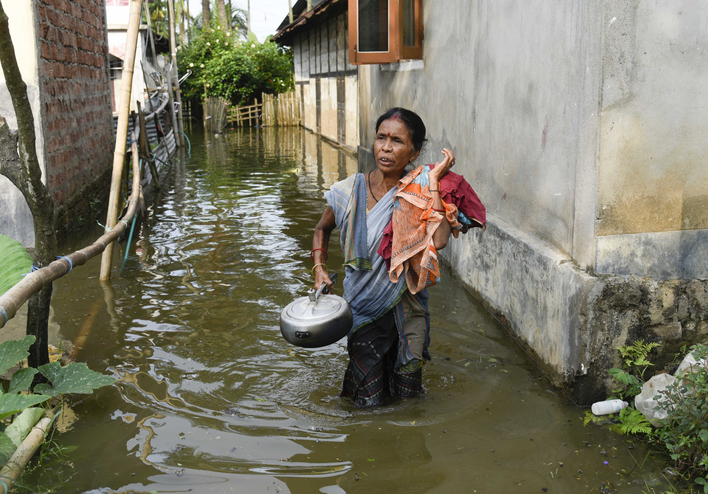Current attempts to mitigate the risks from natural disasters in developing countries are inadequate. This column evaluates potential solutions in the form of financial instruments of risk transfer, such as insurance. The authors conclude that there are several ways in which risk transfer instruments may help governments to provide better post-disaster aid. But there is no magic bullet. Donors and governments need to think carefully about the precise problems they face, and which form of risk transfer instrument may help them.
Natural disasters are responsible for huge amounts of damage across the world, with households, businesses, and local governments all at risk of suffering important losses. Most of the deaths and serious injuries resulting from these disasters are in developing countries.
Despite the fact that many of these disasters are relatively foreseeable, current attempts to reduce their impact appear to be grossly insufficient. Those at risk are generally under-protected, and frequently appear to under-invest in actions that would mitigate losses. Governments and donors provide some relief, but this is often too small and inefficiently allocated.
In this context, increasing attention is turning to risk transfer instruments as a potential solution. These instruments—such as reinsurance, catastrophe bonds, and catastrophe swaps—essentially replace or complement ad hoc post-disaster benefactor relief with some kind of insurance, most often provided through the private sector.
Critics argue that these instruments are expensive and opaque, with private financiers able to take advantage of limited competition and relatively poorly informed customers. Indeed, for all but the most extreme potential disasters, financing disaster responses through savings or debt does seem to be more cost-effective in the long run. Yet a range of developing countries continue to purchase or subsidize these instruments with support from international institutions, despite the high costs.
In recent research, we ask whether risk transfer instruments, such as insurance, can provide value to governments beyond budget smoothing, and hence improve the aid that individuals receive from governments and donors. In particular, we identify three distinct problems that may arise due to the inability of benefactors to commit.
The first problem is that disaster relief may be prone to a problem of ‘moral hazard’ and the classical ‘Samaritan’s dilemma’. In particular, this includes those at risk who deliberately under-protect themselves knowing that governments or donors will come to their rescue.
The second problem is that benefactors do not undertake the necessary steps to avoid disaster relief misallocation. Many people who should receive aid do not, and sometimes funds are diverted to those who suffered no losses at all. This problem stems from the fact that in the procedure of aid allocation, it is difficult to monitor exactly where the losses occurred and to what extent. Accordingly, there is general mistrust of claims for payouts made by recipients or the agency responsible for disaster relief. The mistrust in the probability of claims being valid effectively results in the benefactor giving less aid.
Finally, disaster relief frequently arrives too late. Besides practical reasons for aid not arriving in a timely fashion, benefactors may wait to see what other donors give before giving themselves. This may be motivated by the wish to obtain a clearer idea of the burden-sharing among donors before making payments.
Mitigating commitment problems via risk transfer
Especially in countries with poor governance, it is not feasible to solve commitment problems by improving the functioning and credibility of the respective relief institutions. Instead, investing in a system of risk transfer to third parties might be a more effective solution, and it has become part of countries’ strategies for disaster risk finance. Our study considers four properties of schemes for risk transfer to third parties, each having different implications for the problems of commitment.
Recipient insurance subsidies
Benefactors may purchase insurance for people at risk or mandate them to do so. They may also subsidize insurance, taking over a fixed or proportional part of the premium payment. The Samaritan’s dilemma can be mitigated, especially if only a proportion of the premium is subsidized. Then, it is clear to the recipient that aid from the benefactor is only coming if insurance was bought in the first place and in what amount. At the same time, the risk-based premium signals the risk to be covered and gives an appropriate incentive for self-protection.
Reduced delay of disbursement may also result because benefactors potentially find it easier to coordinate over a subsidy rather than over immediate relief. In addition, the timing of the payout and the share taken by the benefactor are clear prior to disaster and independent of other donors.
Benefactor (re)insurance
Benefactors may coordinate with other donors prior to disaster and purchase insurance for themselves.
Having access to insurance and funds that are contingent on the size of the disaster can help mitigate the Samaritan’s dilemma by allowing benefactors to reduce access to other kinds of funding. In this way, benefactors can commit more easily not to fund more than promised while still having funds available in the event of large disasters.
Delayed disbursement is easier to tackle as benefactors are able to coordinate more easily over jointly purchasing such a policy compared with coordinating over post-disaster aid.
Common payout triggers
Benefactors may ensure that there are ‘common payout triggers’ across their relief efforts, particularly those of the third party and the private sector.
Since the private sector has a further incentive not to misallocate payouts, aid misallocation is reduced through subsidizing recipient insurance and aligning relief efforts with the mechanisms of the private sector (that is, combining payout triggers).
Disaster indices
Benefactors may construct ‘disaster loss indices’ by gathering and publishing statistics on proxies for disaster losses (for example, satellite data on wind speed and rainfall) in order to trigger aid payments.
Disaster indices counteract the Samaritan’s dilemma if they are sufficiently accurate and benefactors rely on them rather than trying to observe the true losses. If so, the benefactor’s behavior is independent of the self-protection decision.
Disaster indices may also be less vulnerable to misallocation. Still, the effect also depends on the probability of the index being reported correctly. If there is a high risk of the index being wrong, misallocation may still happen and the problem of having a truthful account of the actual situation remains.
Conclusion
Overall, we conclude that there are several ways in which risk transfer instruments may help governments to provide better post-disaster aid. But there is no magic bullet. Donors and governments need to think carefully about the precise problems they face, and which form of risk transfer instrument may help them.
Moreover, many of the potential benefits described in this column remain untested. There is thus an important need for empirical research to understand when risk transfer instruments are worth the cost.







